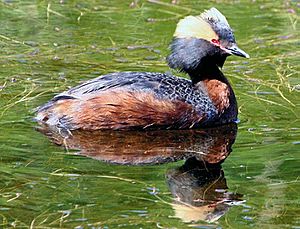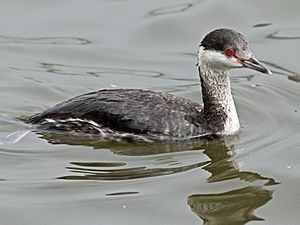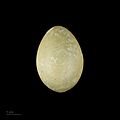Horned grebe facts for kids
Quick facts for kids Horned grebe |
|
|---|---|
 |
|
| Conservation status | |
| Scientific classification | |
| Kingdom: | |
| Class: | |
| Order: | |
| Family: | |
| Genus: |
Podiceps
|
| Binomial name | |
| Podiceps auratus (Linnaeus, 1758)
|
|
The horned grebe or Slavonian grebe (Podiceps auritus) is a fascinating water bird. It belongs to the grebe family. You can find these birds in many places across Eurasia (Europe and Asia) and North America.
The name Podiceps comes from Latin words. Podicis means "rump" and pedis means "foot." This describes where the bird's legs are placed on its body. The word auritus is Latin for "eared," which refers to the special feathers on its head that look a bit like ears or horns.
Contents
What Does a Horned Grebe Look Like?
The horned grebe is easy to recognize! It has two main looks depending on the season.
- During the breeding season, it wears bright red and black feathers. This is called its alternate plumage.
- When it's not breeding, it has a simpler black and white look. This is its basic plumage.
- It also has special "horns" of feathers on its head, which give it its name.
These birds are usually about 31 to 38 centimeters (12 to 15 inches) long. Their wings can spread wide, from 55 to 74 centimeters (22 to 29 inches). They weigh between 300 and 570 grams (about 0.6 to 1.2 pounds).
Body Features
The horned grebe has a neck that is not too long. Its forehead is flat, and the back of its head has black feathers. Its beak is straight and pointy, with a white tip.
There are two main types, or subspecies, of horned grebes. They look quite similar.
- P. a. auritus lives in Eurasia and tends to be a bit darker.
- P. a. cornutus lives in North America and has light grey feathers on its back.
Sometimes, people confuse the horned grebe with the black-necked grebe. They are similar in size and color. However, the black-necked grebe has a steeper forehead, a thinner beak, and a fluffier rump (the back part of its body).
Breeding Plumage
When horned grebes are ready to breed, their feathers become very colorful. This is their alternate plumage.
- They grow bright, upright "horns" of feathers on their heads.
- They have black, fan-shaped feathers on their cheeks.
- Their neck, sides, and upper chest turn a chestnut brown color.
- The top of their head and their back are black.
- Their belly is a dull white.
Male and female horned grebes look very much alike during this time. Males might be slightly bigger and brighter, but it's hard to tell them apart.
Non-Breeding Plumage
When it's not breeding season, the horned grebe's feathers are mostly black and white. This is its basic plumage.
- Its neck, chest, and cheeks are white.
- Its back and the top of its head are a dull black-grey.
- A straight line separates the top of its head from its cheeks, going behind its eyes.
- The "horns" are not present in this plumage.
Young Grebes
Young horned grebes, called juveniles, look a lot like non-breeding adults. However, their white feathers are a bit duller, and their backs have a brownish tint. The line between their cheeks and the top of their head is not as clear, and their beak is paler.
Baby horned grebes, called chicks, are very fluffy. They have a dull grey back and a white belly. They also have cool black and white stripes on their faces!
Images for kids
See also
 In Spanish: Zampullín cuellirrojo para niños
In Spanish: Zampullín cuellirrojo para niños





